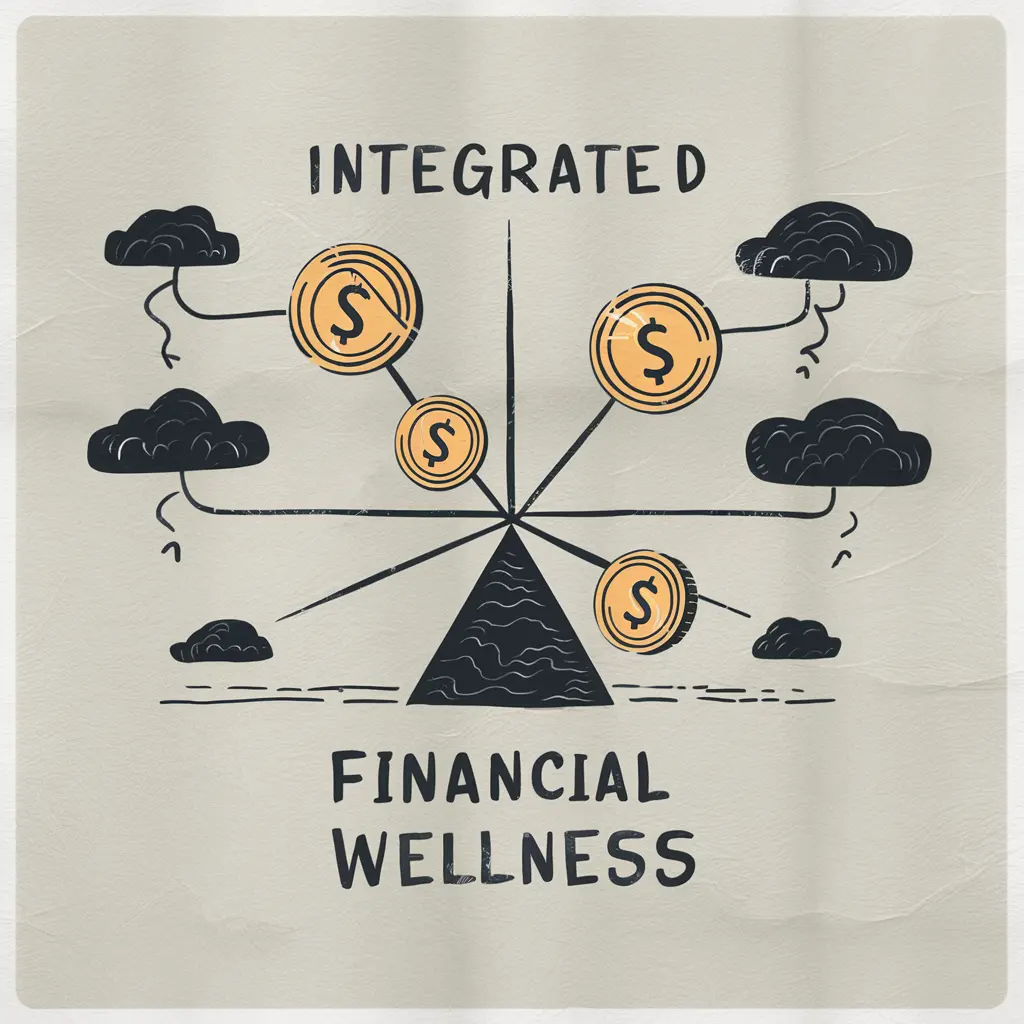Financial planning is a crucial aspect of achieving long-term financial security and meeting your life goals. However, traditional approaches to personal financial planning often fall short, failing to adapt to the ever-changing landscape of modern life. This is where new models for personal financial planning come into play, offering innovative and data-driven solutions tailored to your unique needs.
In this article, we’ll explore the limitations of traditional financial planning methods and delve into the emerging trends shaping the future of personal finance management. We’ll introduce you to cutting-edge approaches, such as:
- Goal-based financial planning
- Automated financial planning with robo-advisors
- Integrated financial wellness strategies
- Collaborative financial planning models
Get ready to embark on a journey towards a more holistic, personalized, and technology-driven approach to managing your finances effectively.
The Limitations of Traditional Financial Planning

A. Rigid and inflexible approaches
While traditional financial planning methods have served as a foundation for many years, they often fail to address the complexities and unique circumstances of modern life. These outdated approaches can be rigid, inflexible, and struggle to adapt to changing goals, priorities, and financial situations.
B. Lack of personalization
One major limitation is the lack of personalization. Traditional financial plans are often based on generic assumptions and models, failing to account for individual preferences, risk tolerance, and life stages. This one-size-fits-all approach can lead to misaligned strategies that don’t truly resonate with your specific needs and aspirations.
C. Difficulty in adapting to changing circumstances
Another challenge is the difficulty in adapting to changing circumstances. Life is unpredictable, and unexpected events, such as job changes, family dynamics, or market fluctuations, can significantly impact your financial situation. Traditional plans may not have the flexibility to adjust and accommodate these shifts, leaving you ill-prepared to navigate financial challenges or seize new opportunities.
D. Failure to leverage technology and data

Furthermore, traditional financial planning methods have been slow to embrace technology and data-driven decision-making. With the rise of financial technology (FinTech) and the abundance of personal data available, there is a growing demand for more sophisticated and personalized approaches that can leverage these resources effectively.
Lastly, traditional plans often focus solely on financial aspects, neglecting the interconnectedness between our finances and overall well-being. Money management is not just about numbers; it’s deeply intertwined with our emotions, values, and life satisfaction. Failing to address this holistic perspective can lead to imbalances and missed opportunities for achieving true financial wellness.
To overcome these limitations, new models for personal financial planning have emerged, driven by technological advancements, data-driven insights, and a better understanding of individual needs and preferences.
In the following sections, we’ll explore these innovative approaches and how they can help you navigate your financial journey more effectively.
Emerging Trends in Personal Finance

The landscape of personal finance is rapidly evolving, fueled by technological advancements and shifting consumer demands. These emerging trends are paving the way for more personalized, data-driven, and holistic approaches to financial planning.
A. The rise of financial technology (FinTech)
One of the most significant trends is the rise of financial technology (FinTech). FinTech companies are leveraging cutting-edge technologies, such as artificial intelligence (AI), machine learning, and big data analytics, to revolutionize the way we manage our finances.
From mobile apps and robo-advisors to automated budgeting tools and personalized investment recommendations, FinTech solutions are making financial planning more accessible, convenient, and tailored to individual needs.
B. Data-driven decision making
Data-driven decision-making is another trend that is transforming the financial planning landscape. With the abundance of personal data available, including spending patterns, income streams, and investment portfolios, financial planners can now gain deeper insights into individual circumstances and preferences.
By leveraging data analytics, they can develop more accurate and personalized strategies, helping individuals make informed decisions and optimize their financial outcomes.
C. Personalization and customization
Personalization and customization are becoming increasingly important in financial planning. Gone are the days of one-size-fits-all solutions. Consumers are demanding tailored approaches that align with their unique goals, risk tolerance, and life stages. Financial planners are embracing this trend by offering personalized services and leveraging technology to create customized plans that evolve with an individual’s changing needs.
D. Holistic wealth management
There is a growing recognition of the interconnectedness between financial well-being and overall wellness. Traditional financial planning often focused solely on numbers and returns, overlooking the emotional and psychological aspects of money management.
Emerging models are embracing a holistic approach, integrating physical, mental, and emotional well-being into financial planning strategies. This approach recognizes that achieving true financial success requires a balance between financial goals and overall life satisfaction.
These trends are reshaping the personal finance industry, creating new opportunities for individuals to take control of their financial futures. By staying informed and embracing these innovative approaches, you can unlock the potential for more efficient, personalized, and fulfilling financial planning experiences.
New Models for Personal Financial Planning

In response to the limitations of traditional approaches and the emerging trends in personal finance, several innovative models for financial planning have gained traction. These new models aim to provide personalized, data-driven, and holistic solutions tailored to individual needs and circumstances.
A. Goal-based planning
Goal-Based Financial Planning One of the most popular new models is goal-based financial planning. This approach focuses on aligning your financial strategies with your specific life goals and aspirations, rather than relying on generic benchmarks or one-size-fits-all solutions.
1. Prioritizing and aligning financial goals
With goal-based planning, you start by identifying your short-term, medium-term, and long-term goals, such as buying a home, funding your children’s education, or achieving a comfortable retirement. Your financial plan is then tailored to help you achieve these goals within your desired timeframes and risk tolerance.
2. Flexible and adaptable strategies
This model allows for greater flexibility and adaptability. As your goals or circumstances change, your financial plan can be adjusted accordingly, ensuring that your strategies remain relevant and effective.
B. Automated financial planning

1. Robo-advisors and algorithm-based investment management
Automated Financial Planning with Robo-Advisors Another innovative model is automated financial planning, powered by robo-advisors and algorithm-based investment management. Robo-advisors are digital platforms that use advanced algorithms and data analysis to provide personalized investment advice and portfolio management services.
2. Automated budgeting and expense tracking
These automated services can help streamline various aspects of financial planning, such as asset allocation, portfolio rebalancing, and tax optimization. By leveraging technology and data-driven insights, robo-advisors can offer cost-effective and personalized investment solutions tailored to your risk profile and financial goals.
C. Integrated financial wellness

1. Incorporating physical, mental, and emotional well-being
Integrated Financial Wellness Strategies Recognizing the interconnectedness between financial well-being and overall wellness, some financial planners are adopting integrated financial wellness strategies. This holistic approach goes beyond just managing numbers and portfolios; it incorporates physical, mental, and emotional well-being into the financial planning process.
2. Mindful spending and lifestyle choices
Integrated financial wellness strategies may include mindful spending practices, lifestyle coaching, and techniques for managing financial stress and anxiety. By addressing the psychological and emotional aspects of money management, these strategies aim to help individuals achieve a balanced and fulfilling relationship with their finances.
D. Collaborative financial planning

Collaborative Financial Planning Models Another emerging model is collaborative financial planning, which involves a team of professionals working together to provide comprehensive financial solutions. This approach recognizes that financial planning encompasses various interconnected aspects, such as investment management, tax planning, estate planning, and risk management.
1. Leveraging expertise from various professionals
In a collaborative model, you work with a team of experts, including financial advisors, accountants, attorneys, and other specialists, who coordinate their strategies and expertise to develop a cohesive financial plan tailored to your unique needs and goals. This collaborative approach ensures that all aspects of your financial life are addressed in a coordinated and synergistic manner.
2. Leveraging expertise from various professionals
These new models for personal financial planning represent a shift towards more personalized, flexible, and holistic approaches to money management. By embracing these innovative strategies, you can take control of your financial future and achieve your goals while maintaining a healthy balance between financial success and overall well-being.
For More Information Read More Article:
V. Practical Implementation

Adopting new models for personal financial planning requires more than just understanding the concepts; it involves taking practical steps to implement these strategies effectively. By following a structured approach, you can ensure a smooth transition and maximize the benefits of these innovative financial planning methods.
A. Assessing your current financial situation
Assessing Your Current Financial Situation The first step is to gain a comprehensive understanding of your current financial situation. This includes evaluating your income sources, expenses, debts, assets, and investment portfolios. Additionally, it’s essential to identify your short-term and long-term financial goals, risk tolerance, and any specific life events or milestones that may impact your financial plan.
B. Identifying your goals and priorities
Identifying Your Goals and Priorities Once you have a clear picture of your current financial landscape, the next step is to define your goals and priorities. This could include saving for a down payment on a home, funding your retirement, or building an emergency fund. Prioritize your goals based on their importance and urgency, as this will guide the development of your financial plan.
C. Choosing the right tools and resources
Choosing the Right Tools and Resources With the abundance of financial technology and tools available, it’s crucial to select the ones that align with your specific needs and preferences. Explore robo-advisors, budgeting apps, investment management platforms, and other digital solutions that can help streamline and automate various aspects of your financial planning process.
D. Building a customized financial plan

Building a Customized Financial Plan Armed with a deep understanding of your financial situation, goals, and the right tools, you can now begin building a customized financial plan that incorporates the principles of new financial planning models. This may involve setting up automated savings and investment strategies, implementing goal-based budgeting, or collaborating with a team of professionals to develop a comprehensive wealth management strategy.
E. Monitoring progress and making adjustments
Monitoring Progress and Making Adjustments Financial planning is an ongoing process, not a one-time event. Regularly monitor your progress towards achieving your goals and be prepared to make adjustments as needed. Embrace the flexibility of these new models, which allow you to adapt your strategies to changing circumstances, market conditions, or shifting priorities.
Seeking Professional Guidance While many aspects of new financial planning models can be self-directed, it’s often beneficial to seek guidance from qualified professionals. Financial advisors, certified financial planners, and other experts can provide valuable insights, personalized advice, and accountability to help you navigate the complexities of financial planning effectively.
By following these practical steps, you can successfully implement new models for personal financial planning and unlock the potential for more personalized, data-driven, and holistic approaches to managing your finances. Remember, financial planning is a journey, and these innovative models empower you to take control and achieve your goals while maintaining a healthy balance between financial success and overall well-being.
VI. Case Studies and Examples

To better illustrate the practical applications and benefits of these new models for personal financial planning, let’s explore some real-world case studies and examples.
A. Success stories of individuals who adopted new financial planning models
Meet Sarah and Tom, a young couple in their early 30s. They recently had their first child and were feeling overwhelmed with managing their finances amidst the new responsibilities of parenthood. Recognizing the limitations of their traditional financial plan, they decided to embrace a goal-based approach.
With the help of a financial advisor, Sarah and Tom identified their key goals: saving for their child’s education, paying off their mortgage faster, and building a retirement nest egg. Their advisor developed a customized plan that aligned their investment strategies, budgeting, and risk management tactics with these specific goals.
Through regular check-ins and progress tracking, Sarah and Tom were able to make adjustments as their family’s needs evolved. The flexibility of the goal-based model allowed them to navigate life’s surprises while staying on track towards their long-term objectives.
B. Practical examples of how these models can be applied Case Studies and Examples
Another example is Mike, a tech-savvy professional in his late 20s. Feeling overwhelmed by the complexity of managing his finances, Mike turned to automated financial planning solutions powered by robo-advisors.
After answering a series of questions about his risk tolerance, investment preferences, and financial goals, the robo-advisor platform generated a personalized investment portfolio tailored to his needs. The platform also provided automated rebalancing, tax optimization strategies, and ongoing portfolio monitoring.
Mike appreciated the convenience and transparency of the robo-advisor, as well as the ability to make adjustments and track his progress through a user-friendly mobile app. The data-driven insights and automated features helped him stay on top of his investments without the need for constant manual intervention.
Lastly, let’s consider Emily, a successful entrepreneur in her mid-40s. As her business grew and her wealth accumulated, Emily recognized the importance of taking a holistic approach to her financial planning. She sought the guidance of a collaborative team of professionals, including a financial advisor, accountant, and estate planning attorney.
Together, they developed a comprehensive wealth management strategy that addressed not only her investment goals but also tax planning, risk management, and legacy planning. The collaborative model ensured that all aspects of Emily’s financial life were coordinated and optimized.
Emily’s team incorporated integrated financial wellness strategies, helping her manage the stress and emotional aspects of wealth accumulation. Through mindfulness practices and lifestyle coaching, Emily was able to maintain a healthy work-life balance and align her financial decisions with her personal values and overall well-being.
These case studies demonstrate the diverse applications of new financial planning models, catering to various life stages, goals, and preferences. By embracing these innovative approaches, individuals and families can take control of their financial futures, achieve their objectives, and maintain a balanced and fulfilling relationship with their finances.
Future Outlook

A. Emerging trends and innovations in personal finance
As we look ahead, the landscape of personal financial planning is poised for even more transformative changes. Emerging trends and innovations in technology, data analytics, and consumer preferences will continue to shape the way we approach money management.
B. The role of artificial intelligence and machine learning
One of the most exciting developments on the horizon is the integration of artificial intelligence (AI) and machine learning into financial planning tools and services. AI-powered platforms will be able to analyze vast amounts of data, including personal financial information, market trends, and economic indicators, to provide highly personalized and predictive financial advice.
These advanced algorithms will not only optimize investment strategies but also anticipate potential risks and opportunities, allowing for proactive decision-making and course correction. AI-powered virtual assistants and chatbots will further enhance the user experience, providing on-demand financial guidance and answering complex queries with human-like intelligence.
C. The importance of adaptability and continuous learning
The growing adoption of open banking and data sharing initiatives will enable seamless integration of financial data from various sources, such as bank accounts, investment portfolios, and credit reports. This interconnectivity will empower financial planning platforms to offer a comprehensive view of an individual’s financial landscape, leading to more accurate and holistic recommendations.
Another trend to watch is the rise of voice-enabled and conversational interfaces in personal finance applications. As virtual assistants like Siri, Alexa, and Google Assistant become more sophisticated, users will be able to manage their finances through natural language interactions, making financial planning more accessible and convenient.
In addition to technological advancements, there will be an increased emphasis on financial education and literacy. As new models for personal financial planning become more prevalent, individuals will need to develop a deeper understanding of financial concepts, risk management strategies, and the tools available to them.
D. Financial institutions

Financial institutions, educational organizations, and industry professionals will play a crucial role in providing accessible and engaging financial literacy programs, empowering individuals to make informed decisions and navigate the complexities of modern financial planning.
Lastly, the importance of adaptability and continuous learning cannot be overstated. The financial landscape is constantly evolving, and new regulations, economic conditions, and market dynamics will necessitate ongoing adjustments to financial planning strategies.
Successful individuals and professionals will need to embrace a mindset of lifelong learning, staying abreast of emerging trends and being willing to adapt their approaches to align with changing circumstances. Continuous education and professional development will be essential for financial planners to remain relevant and provide cutting-edge solutions to their clients.
As we embrace these future developments, the world of personal financial planning will become more personalized, data-driven, and integrated with our daily lives. By staying informed and open to new models and technologies, individuals can take control of their financial futures and achieve their goals while maintaining a healthy balance between financial success and overall well-being.
Conclusion
In the ever-evolving landscape of personal finance, embracing new models for financial planning is crucial to achieving long-term success and maintaining a balanced relationship with your money. Traditional approaches, while valuable in their own right, often fall short in addressing the complexities and unique circumstances of modern life.
The innovative models we’ve explored, such as goal-based financial planning, automated financial planning with robo-advisors, integrated financial wellness strategies, and collaborative financial planning models, offer personalized, data-driven, and holistic solutions tailored to your individual needs and aspirations.
By adopting these new approaches, you can take control of your financial future, navigate life’s challenges with greater flexibility, and achieve your goals while prioritizing your overall well-being. Remember, financial planning is an ongoing journey, and staying informed about emerging trends and continuously adapting your strategies is key to long-term success.
Embrace the future of personal finance and unlock the potential for a more empowered, fulfilling, and financially secure life. The time to explore and implement these new models is now.

James Wilson is the insightful financial writer behind the wealth of knowledge on WealthWaves. With a keen understanding of finance and a passion for helping others navigate the complexities of money management, they specialize in crafting informative articles, practical tips, and expert advice to empower readers on their journey to financial freedom.
Join James Wilson on WealthWaves to embark on a path towards financial success and prosperity.








